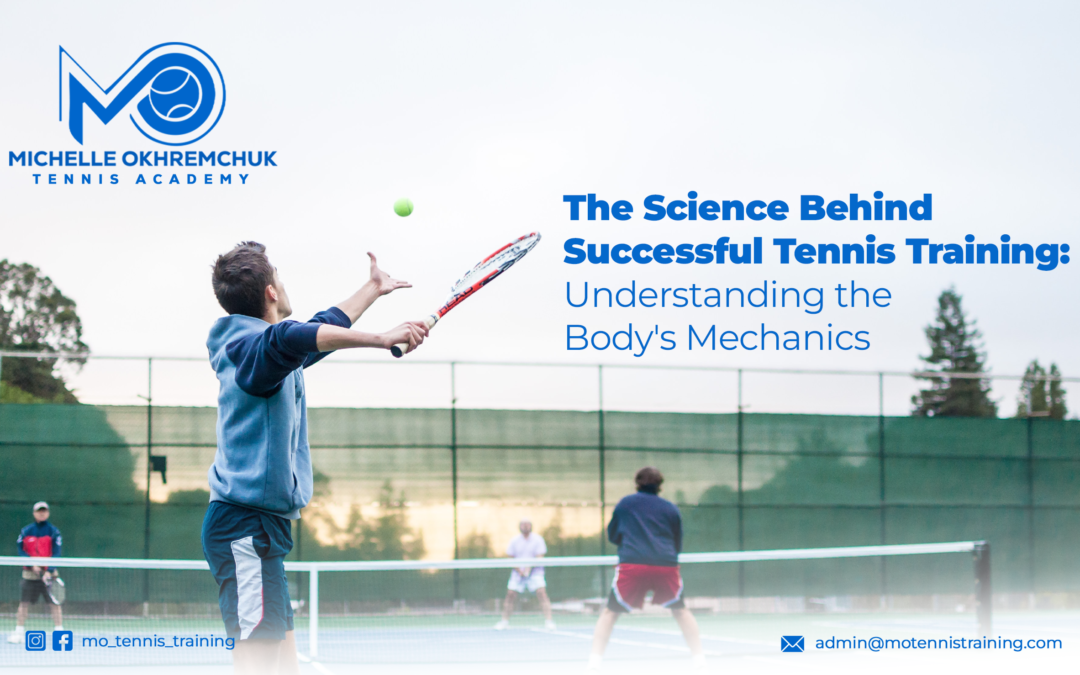If you’ve ever found yourself struggling to control the ball or harness the full power of your shots, you’re not alone. Often, the key to unlocking your full potential lies in understanding the fundamental mechanics of tennis strokes.
While it’s natural to emulate the playing style of your favorite tennis pros, true mastery of the game goes beyond surface-level mimicry. At its core, tennis development is intricately linked to biomechanics—the study of human motion in its entirety.
By delving into the science of biomechanics, we gain valuable insights into the efficiency of movement, consistency, and power generation.
Central to this understanding is the concept of the kinetic chain—a systematic interplay of body segments that culminates in racket velocity and control. From the legs grounding the force to the trunk transferring it to the arms and racket, each link in this chain plays a crucial role in optimizing performance on the court.
Recognizing and correcting errors in this kinetic chain is essential for teaching professionals to enhance their players’ stroke production and minimize inefficiencies.
By dissecting the mechanics behind each movement, we’ll equip you with the knowledge and insights needed to refine your technique and dominate the court with confidence.
Let’s dive right in.
The Importance of Understanding the Body’s Mechanics in Tennis
When it comes to excelling in tennis, understanding the body’s mechanics is crucial. Every movement on the court relies on a complex interplay between muscles, joints, and coordination. By developing a deep understanding of how your body works during each shot, you can optimize your performance and minimize the risk of injury.
Tennis involves explosive movements such as sprinting, jumping, and quick direction changes. These actions put tremendous strain on various muscle groups and joints throughout the body. Without proper knowledge of how these movements affect our bodies, we run the risk of overexertion or inefficient technique.
By studying biomechanics – the science that analyzes human movement – players can gain insights into their own strengths and weaknesses. This knowledge allows them to tailor their training programs accordingly. For example, if you know that your backhand lacks power due to weak core muscles, you can focus on specific exercises to strengthen those areas.
Understanding body mechanics also helps prevent injuries commonly associated with tennis. By learning correct techniques for striking a ball or moving across the court, players reduce stress on vulnerable joints like knees and shoulders. Additionally, knowing how improper posture or footwork affects different parts of our bodies enables us to make necessary adjustments.
The Role of Muscles and Joints in Tennis Movements
Muscles play a crucial role in generating force and power during tennis strokes. The primary muscles involved are those of the upper body, including the shoulders, chest, arms, and core. The shoulder muscles help with racket control and acceleration, while the chest muscles provide stability during shots. Strong arm muscles contribute to a powerful swing, while a strong core helps maintain balance and stability throughout the game.
Strong leg muscles are essential for quick movements around the court. The quadriceps and hamstrings enable explosive starts and stops as well as lateral movements required for effective shot positioning.
Joints also play a significant role in tennis movements. The shoulder joint allows for a wide range of motion necessary for serving or overhead shots. The elbow joint facilitates forearm rotation during forehands and backhands. Additionally, wrist mobility is crucial for generating spin on shots.
It’s important to note that proper technique is essential in minimizing stress on these muscle groups and joints to prevent injuries such as tendonitis or strains. Regular stretching before matches can help improve flexibility, which can reduce muscle imbalances.
Remember that each player has unique strengths or weaknesses when it comes to their body mechanics! Work with an experienced coach like Michelle Okhremchuk from Mo Tennis Training Academy in San Diego, who specializes in science-based training methods tailored specifically towards improving tennis players’ performance!
Common Injuries in Tennis and How to Prevent Them
One of the most common injuries in tennis is tennis elbow, also known as lateral epicondylitis. This injury occurs when the tendons in the forearm become inflamed due to repetitive motions like swinging a racket. To prevent this injury, it’s important to use proper technique and equipment, warm up before playing, and strengthen the muscles in the forearm through targeted exercises.
Another common injury is shoulder impingement syndrome. This occurs when the rotator cuff tendons are compressed or irritated in the shoulder joint. To prevent this injury, players should focus on strengthening their shoulder muscles through specific exercises targeting all aspects of shoulder mobility.
Knee injuries are also prevalent among tennis players, with patellar tendonitis being one of the most common conditions. This injury involves inflammation or degeneration of the patellar tendon that connects your kneecap to your shinbone. To avoid knee injuries, it’s crucial for tennis players to maintain strong quadriceps muscles and perform exercises that improve stability around the knee joint.
Ankle sprains are another frequent occurrence on the court. These typically happen when a player lands awkwardly after jumping or changes direction suddenly while running. Wearing supportive shoes with good ankle support can significantly reduce these types of injuries.
Key Exercises for Improving Strength and Agility in Tennis Players
Strength and agility are crucial components of a successful tennis player’s game. By incorporating specific exercises into your training routine, you can enhance these attributes and take your performance on the court to new heights. Here are some key exercises that will help improve your strength and agility as a tennis player.
Plyometric Training: Plyometrics involve explosive movements like jumps, hops, and bounds. These exercises build power in the lower body muscles, improving speed and quickness on the court.
Resistance Training: Incorporating resistance bands or weights into your workouts can help strengthen the muscles used during tennis-specific movements like serves, forehands, backhands, and volleys.
Core Strengthening Exercises: A strong core is essential for stability during swift changes in direction while maintaining balance on the court. Incorporate exercises such as planks, Russian twists, and medicine ball throws to target your core muscles.
Speed ladder drills: Utilizing speed ladder drills can improve footwork coordination, reaction time, and overall agility needed to move swiftly across the court.
Agilitiy Cone Drills: Set up cones at various distances apart to simulate different shots or movement patterns required on the tennis court. Practice side shuffles, forward-backward sprints between cones while focusing on quick change of direction.
Remember that consistency is key if you want to see improvements in strength and agility as a tennis player! Make these exercises part of your regular training routine alongside proper nutrition habits for optimal results.
Nutrition Tips for Optimal Performance on the Court
Nutrition plays a crucial role in optimizing performance on the tennis court. Fueling your body with the right nutrients can enhance your energy levels, improve focus, and aid in recovery.
Here are some essential nutrition tips to help you perform at your best:
Hydration is key: Staying hydrated before, during, and after matches or training sessions is vital for maintaining optimal performance. Drink water regularly throughout the day and consider adding electrolyte-rich sports drinks during intense workouts.
Balance macronutrients: Ensure that your meals include a balance of carbohydrates, proteins, and healthy fats. Carbs provide the fuel needed for physical activity, while proteins support muscle repair and growth.
Prioritize whole foods: Opt for nutrient-dense foods like fruits, vegetables, lean meats, whole grains, nuts, and seeds. These foods provide essential vitamins, minerals and antioxidants necessary for overall health.
Choose pre- and post-workout snacks wisely: Before hitting the court, fuel up with easily digestible carbs such as bananas or oatmeal to sustain energy levels.
Don’t forget about post-workout nutrition either! Aim to consume a combination of protein and carbs within 30 minutes after exercise to promote muscle recovery.
Supplement smartly if needed: While it’s ideal to get all your nutrients from whole foods, sometimes supplements can be beneficial.
Consult with a healthcare professional or registered dietitian who specializes in sports nutrition to determine if any specific supplements may benefit you based on individual needs
Remember that proper nutrition is not only important during training but also contributes significantly to injury prevention, recovery and long-term athletic success.
On top of these general guidelines, it’s always wise to seek personalized advice from experts who can tailor recommendations specifically for YOUR unique needs as a tennis player.
Conclusion
We have explored the science behind successful tennis training and how understanding the body’s mechanics can greatly improve your performance on the court. By incorporating scientific principles into your training regimen, you can enhance your strength, agility, prevent injuries, optimize nutrition, and develop mental toughness.
Tennis is a physically demanding sport that requires explosive movements, quick reflexes, and precise coordination. By understanding how our muscles and joints work together during different strokes and footwork patterns, we can train more effectively and efficiently. This knowledge allows us to target specific muscle groups through exercises that mimic on-court movements.
Strength and agility are two key components of successful tennis performance. Incorporating exercises that focus on building core strength will provide stability during powerful shots while improving balance for quick changes in direction on the court. Agility drills help athletes react faster to opponents’ shots while maintaining control over their own movement.
Nutrition plays an essential role in optimizing performance on the court. A diet rich in lean proteins for muscle repair along with carbohydrates for sustained energy levels is crucial for endurance during long matches or intense practice sessions. Hydration should also be prioritized throughout training to avoid fatigue or cramping.
Taking your game to the next level with science-based training involves a holistic approach that involves understanding the body’s mechanics, preventing injuries, improving strength and agility and optimizing your nutrition.
You can get all the help you need by signing up for training sessions at Mo Tennis Training Academy in San Diego.


